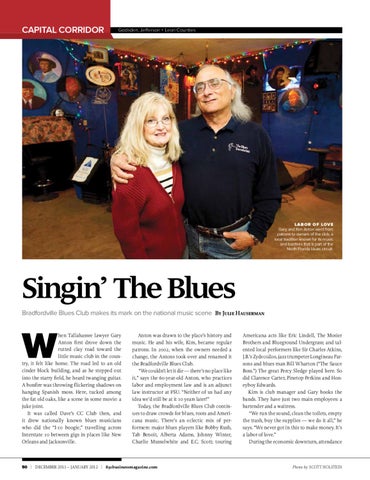Capital Corridor
Gadsden, Jefferson + Leon Counties
Labor o f Love Gary and Kim Anton went from patrons to owners of the club, a local tradition known for its music and bonfires that is part of the North Florida blues circuit.
Singin’ The Blues Bradfordville Blues Club makes its mark on the national music scene By Julie Hauserman
W
hen Tallahassee lawyer Gary Anton first drove down the rutted clay road toward the little music club in the country, it felt like home. The road led to an old cinder block building, and as he stepped out into the starry field, he heard twanging guitar. A bonfire was throwing flickering shadows on hanging Spanish moss. Here, tucked among the fat old oaks, like a scene in some movie: a juke joint. It was called Dave’s CC Club then, and it drew nationally known blues musicians who did the “I-10 boogie,” travelling across Interstate 10 between gigs in places like New Orleans and Jacksonville.
50
|
DECEMBER 2011 – JANUARY 2012
|
Anton was drawn to the place’s history and music. He and his wife, Kim, became regular patrons. In 2002, when the owners needed a change, the Antons took over and renamed it the Bradfordville Blues Club. “We couldn’t let it die — there’s no place like it,” says the 60-year-old Anton, who practices labor and employment law and is an adjunct law instructor at FSU. “Neither of us had any idea we’d still be at it 10 years later!” Today, the Bradfordville Blues Club continues to draw crowds for blues, roots and Americana music. There’s an eclectic mix of performers: major blues players like Bobby Rush, Tab Benoit, Alberta Adams, Johnny Winter, Charlie Musselwhite and E.C. Scott; touring
850businessmagazine.com
Americana acts like Eric Lindell, The Mosier Brothers and Blueground Undergrass; and talented local performers like Sir Charles Atkins, J.B.’s ZydecoZoo, jazz trumpeter Longineau Parsons and blues man Bill Wharton (“The Sauce Boss.”) The great Percy Sledge played here. So did Clarence Carter, Pinetop Perkins and Honeyboy Edwards. Kim is club manager and Gary books the bands. They have just two main employees: a bartender and a waitress. “We run the sound, clean the toilets, empty the trash, buy the supplies — we do it all,” he says. “We never got in this to make money. It’s a labor of love.” During the economic downturn, attendance
Photos by SCOTT HOLSTEIN
